Abstract
Selection pressures proposed to account for the convergent evolution of self/not-self recognition systems in lower organisms include defense against microbial parasites and somatic cell variants. Direct support for the existence of somatic cell parasites in natural populations has been lacking. I here report the occurrence of a somatic cell parasite in the cellular slime mold Dictyostelium mucoroides and discuss the implications of this phenomenon to the evolution of mechanisms of somatic tissue compatibility.
Full text
PDF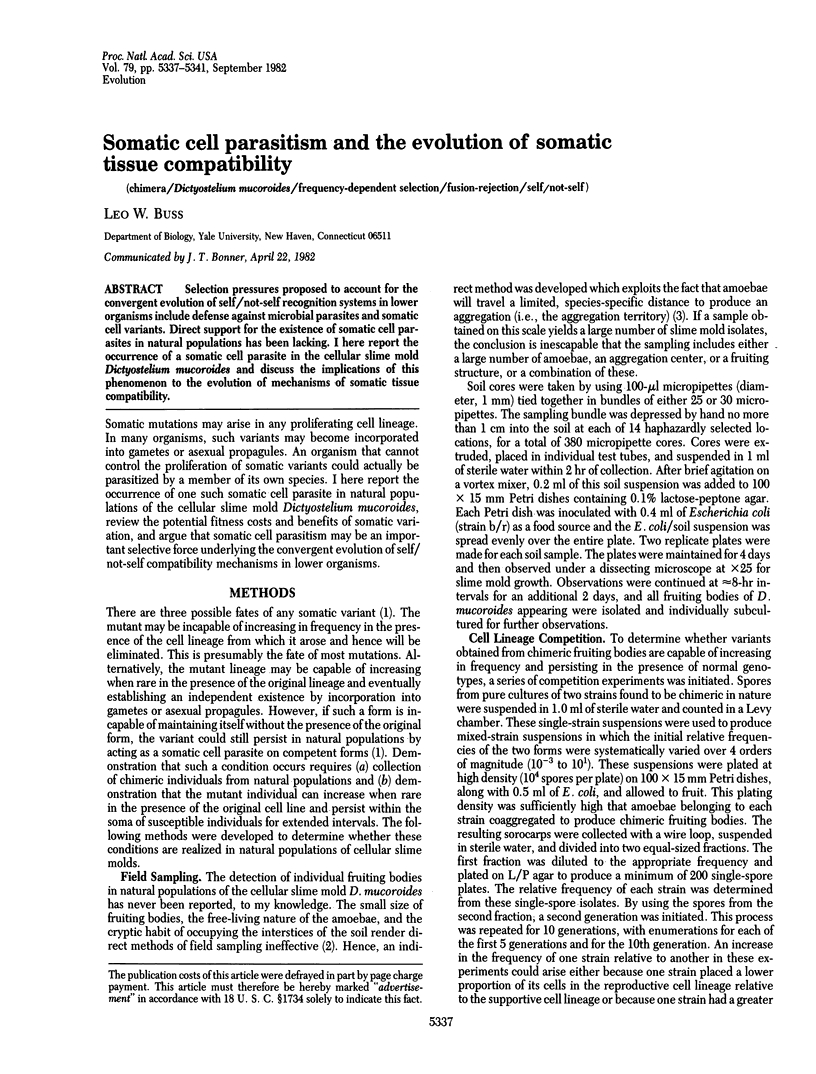
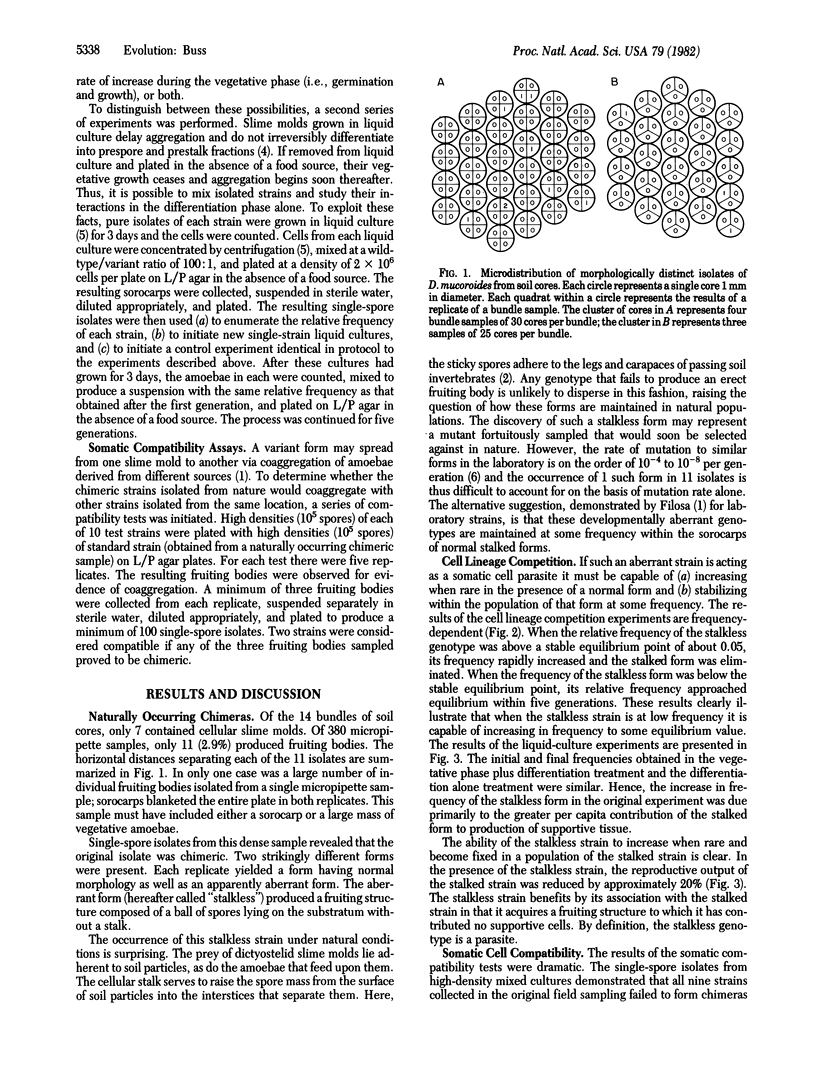
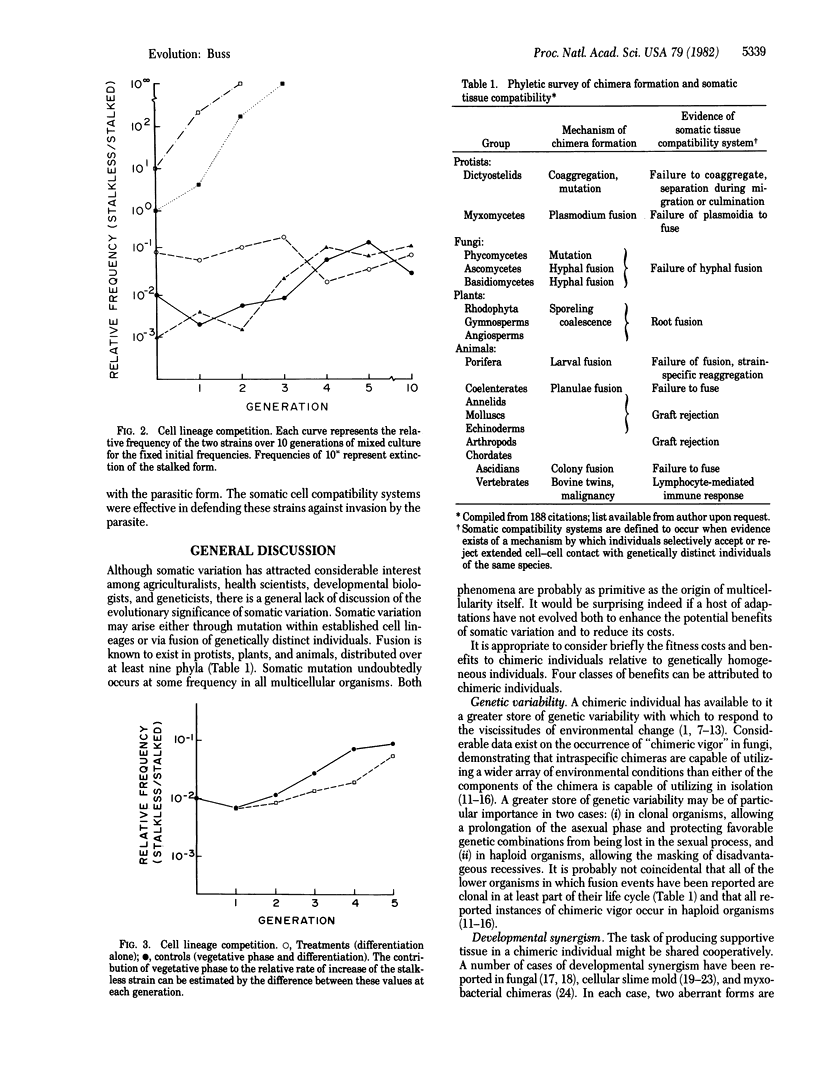
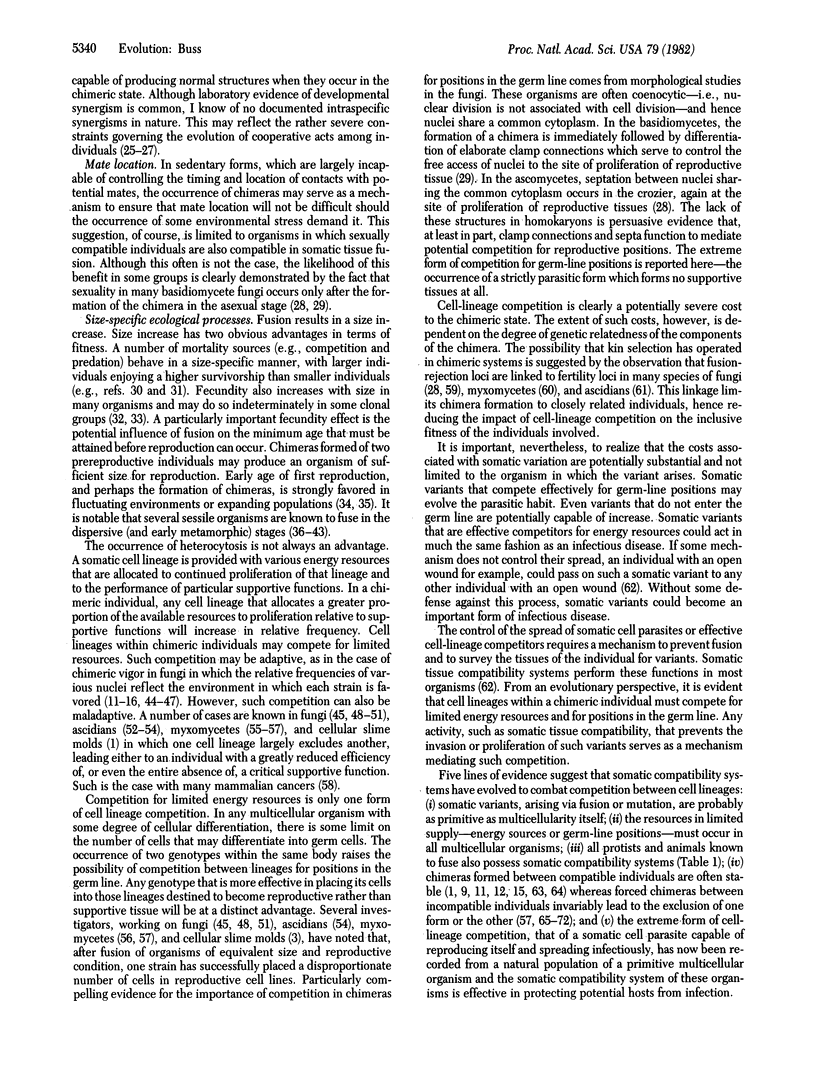
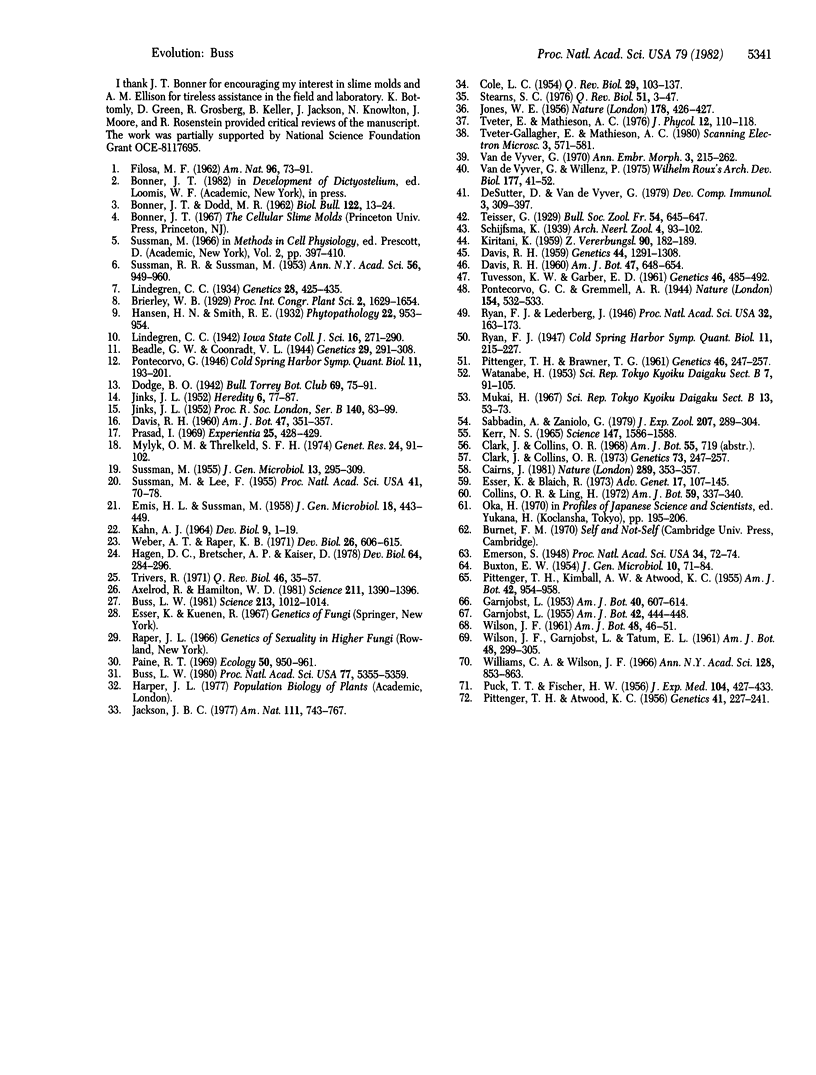
Selected References
These references are in PubMed. This may not be the complete list of references from this article.
- Axelrod R., Hamilton W. D. The evolution of cooperation. Science. 1981 Mar 27;211(4489):1390–1396. doi: 10.1126/science.7466396. [DOI] [PubMed] [Google Scholar]
- BUXTON E. W. Heterocaryosis and variability in Fusarium oxysporum f. gladioli (Snyder & Hansen). J Gen Microbiol. 1954 Feb;10(1):71–84. doi: 10.1099/00221287-10-1-71. [DOI] [PubMed] [Google Scholar]
- Beadle G W, Coonradt V L. Heterocaryosis in Neurospora Crassa. Genetics. 1944 May;29(3):291–308. doi: 10.1093/genetics/29.3.291. [DOI] [PMC free article] [PubMed] [Google Scholar]
- Buss L. W. Competitive intransitivity and size-frequency distributions of interacting populations. Proc Natl Acad Sci U S A. 1980 Sep;77(9):5355–5359. doi: 10.1073/pnas.77.9.5355. [DOI] [PMC free article] [PubMed] [Google Scholar]
- Buss L. W. Group living, competition, and the evolution of cooperation in a sessile invertebrate. Science. 1981 Aug 28;213(4511):1012–1014. doi: 10.1126/science.213.4511.1012. [DOI] [PubMed] [Google Scholar]
- COLE L. C. The population consequences of life history phenomena. Q Rev Biol. 1954 Jun;29(2):103–137. doi: 10.1086/400074. [DOI] [PubMed] [Google Scholar]
- Cairns J. The origin of human cancers. Nature. 1981 Jan 29;289(5796):353–357. doi: 10.1038/289353a0. [DOI] [PubMed] [Google Scholar]
- Clark J., Collins O. R. Directional Cytotoxic Reactions between Incompatible Plasmodia of DIDYMIUM IRIDIS. Genetics. 1973 Feb;73(2):247–257. doi: 10.1093/genetics/73.2.247. [DOI] [PMC free article] [PubMed] [Google Scholar]
- Davis R. Asexual Selection in Neurospora Crassa. Genetics. 1959 Nov;44(6):1291–1308. doi: 10.1093/genetics/44.6.1291. [DOI] [PMC free article] [PubMed] [Google Scholar]
- De Sutter D., Van de Vyver G. Isolation and recognition properties of some definite sponge cell types. Dev Comp Immunol. 1979 Summer;3(3):389–397. doi: 10.1016/s0145-305x(79)80036-1. [DOI] [PubMed] [Google Scholar]
- ENNIS H. L., SUSSMAN M. Synergistic morphogenesis by mixtures of Dictyostelium discoideum wild-type and aggregateless mutants. J Gen Microbiol. 1958 Apr;18(2):433–449. doi: 10.1099/00221287-18-2-433. [DOI] [PubMed] [Google Scholar]
- Emerson S. A Physiological Basis for Some Suppressor Mutations and Possibly for One Gene Heterosis. Proc Natl Acad Sci U S A. 1948 Feb;34(2):72–74. doi: 10.1073/pnas.34.2.72. [DOI] [PMC free article] [PubMed] [Google Scholar]
- Hagen D. C., Bretscher A. P., Kaiser D. Synergism between morphogenetic mutants of Myxococcus xanthus. Dev Biol. 1978 Jun;64(2):284–296. doi: 10.1016/0012-1606(78)90079-9. [DOI] [PubMed] [Google Scholar]
- JINKS J. L. Heterokaryosis; a system of adaption in wild fungi. Proc R Soc Lond B Biol Sci. 1952 Aug 27;140(898):83–99. doi: 10.1098/rspb.1952.0046. [DOI] [PubMed] [Google Scholar]
- KERKUT G. A., TAYLOR B. J. Effect of temperature on the spontaneous activity from the isolated ganglia of the slug, cockroach and crayfish. Nature. 1956 Aug 25;178(4530):426–426. doi: 10.1038/178426a0. [DOI] [PubMed] [Google Scholar]
- KERR N. S. DISAPPEARANCE OF A GENETIC MARKER FROM A CYTOPLASMIC HYBRID PLASMODIUM OF A TRUE SLIME MOLD. Science. 1965 Mar 26;147(3665):1586–1588. doi: 10.1126/science.147.3665.1586. [DOI] [PubMed] [Google Scholar]
- KIRITANI K. Selection of fitter type nuclei in heterocaryons of Aspergillus oryzae. Z Vererbungsl. 1959;90:182–189. doi: 10.1007/BF00888750. [DOI] [PubMed] [Google Scholar]
- Mylyk O. M., Threlkeld S. F. A genetic study of female sterility in Neurospora crassa. Genet Res. 1974 Aug;24(1):91–102. doi: 10.1017/s001667230001510x. [DOI] [PubMed] [Google Scholar]
- Pittenger T H, Atwood K C. Stability of Nuclear Proportions during Growth of Neurospora Heterokaryons. Genetics. 1956 Mar;41(2):227–241. doi: 10.1093/genetics/41.2.227. [DOI] [PMC free article] [PubMed] [Google Scholar]
- Prasad I. Partial complementation in Aspergillus niger heterocaryon. Experientia. 1969 Apr 15;25(4):428–428. doi: 10.1007/BF01899964. [DOI] [PubMed] [Google Scholar]
- Ryan F. J., Lederberg J. Reverse-Mutation and Adaptation in Leucineless Neurospora. Proc Natl Acad Sci U S A. 1946 Jun;32(6):163–173. [PMC free article] [PubMed] [Google Scholar]
- SUSSMAN M. Fruity and other mutants of the cellular slime mould, Dictyostelium discoideum: a study of developmental aberrations. J Gen Microbiol. 1955 Oct;13(2):295–309. doi: 10.1099/00221287-13-2-295. [DOI] [PubMed] [Google Scholar]
- SUSSMAN R. R., SUSSMAN M. Cellular differentiation in dictyosteliaceae; heritable modifications of the developmental pattern. Ann N Y Acad Sci. 1953 Oct 14;56(5):949–960. doi: 10.1111/j.1749-6632.1953.tb30274.x. [DOI] [PubMed] [Google Scholar]
- Stearns S. C. Life-history tactics: a review of the ideas. Q Rev Biol. 1976 Mar;51(1):3–47. doi: 10.1086/409052. [DOI] [PubMed] [Google Scholar]
- Sussman M., Lee F. INTERACTIONS AMONG VARIANT AND WILD-TYPE STRAINS OF CELLULAR SLIME MOLDS ACROSS THIN AGAR MEMBRANES. Proc Natl Acad Sci U S A. 1955 Feb 15;41(2):70–78. doi: 10.1073/pnas.41.2.70. [DOI] [PMC free article] [PubMed] [Google Scholar]
- TUVESON R. W., GARBER E. D. Genetics of phytopathogenic fungi. IV. Experimentally induced alterations in nuclear ratios of heterocaryons of Fusarium oxysporum F. pisi. Genetics. 1961 May;46:485–492. doi: 10.1093/genetics/46.5.485. [DOI] [PMC free article] [PubMed] [Google Scholar]
- VAHARU T. Modification of ultraviolet-induced mutation frequency in Neurospora crassa. Genetics. 1961 Mar;46:247–256. doi: 10.1093/genetics/46.3.247. [DOI] [PMC free article] [PubMed] [Google Scholar]
- Weber A. T., Raper K. B. Induction of fruiting in two aggregateless mutants of Dictyostelium discoideum. Dev Biol. 1971 Dec;26(4):606–615. doi: 10.1016/0012-1606(71)90143-6. [DOI] [PubMed] [Google Scholar]


